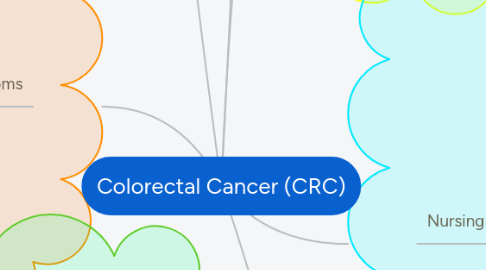Colorectal Cancer (CRC)
by KEI AMPHI BARLINTANGCO

1. Diagnostic Procedures
1.1. Initial testing
1.1.1. CBC - check for amenia
1.1.2. Liver function - CRC may spread to the liver
1.1.3. Colonoscopy
1.1.4. CT colography - if colonoscopy is incomplete
1.2. Diagnostic procedures
1.2.1. Biopsy - performed during colonoscopy
1.2.2. CT needle guided biopsy - to evaluate suspected tumors or metastasis.
2. Signs and Symptoms
2.1. Ribbon (thin) stool
2.2. Obstipation
2.3. Nausea and Vomiting
2.4. Tenesmus
2.5. Rectal pain
2.6. Hematochezia
2.7. Decrease appetite
2.8. Abdominal distention/pain
2.9. Weight loss
2.10. Iron deficiency anemia
3. Nursing Diagnosis
3.1. Acute pain r/t disease process
3.2. Risk for impaired skin integrity r/t radiation and chemotherapy
3.3. Risk for constipation/ diarrhea r/t irritation of the GI mucosa from either chemotherapy or radiation therapy; malabsorption of fat
3.4. Risk for fluid volume deficit r/t impaired intake of fluids
3.5. Anxiety r/t threat to current status
4. Pathophysiology
4.1. inflammatory Bowel Disease
4.2. Smoking
4.3. Idiopathic
4.4. Cell line mutations
4.4.1. Uncontrolled cell division in the colon and rectum
4.4.1.1. Tubular adenomas (pre cancerous polyps)
4.5. Hereditary Syndromes
4.6. Obesity
4.7. Abdominal Radiation
5. Etiology
5.1. Unknown
5.2. Family History of Colorectal Cancer (CRC)
5.3. History of inflammatory bowel disease
5.4. Diet
5.5. Smoking
5.6. Alcohol use
6. Nursing Intervention
6.1. Determine pain history (location of pain, frequency, duration, and intensity using numeric rating scale (0–10 scale), or verbal rating scale (“no pain” to “excruciating pain”) and relief measures used. Believe patient’s report.
6.2. Encourage use of stress management skills or complementary therapies (relaxation techniques, visualization, guided imagery, biofeedback, laughter, music, aromatherapy, and therapeutic touch).
6.3. Encourage patient to avoid vigorous rubbing and scratching and to pat skin dry instead of rubbing.
6.4. Assess bowel sounds and record bowel movements (BMs) including frequency, consistency
6.5. Encourage adequate fluid intake (2000 mL per 24 hours), increased fiber in diet; regular exercise.
6.6. Monitor I&O and specific gravity; include all output sources.
6.7. Assess skin turgor and moisture of mucous membranes. Note reports of thirst.
6.8. Assess skin frequently for side effects of cancer therapy; note breakdown and delayed wound healing. Emphasize importance of reporting open areas to caregiver.
6.9. Provide open environment in which patient feels safe to discuss feelings or to refrain from talking.
6.10. Encourage patient to share thoughts and feelings.



